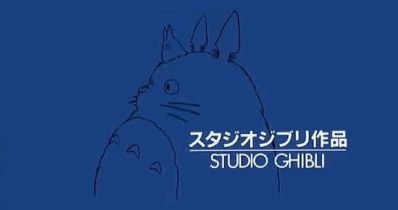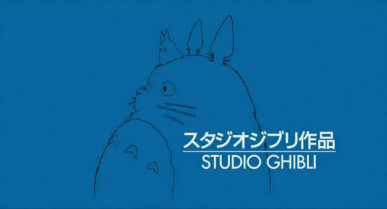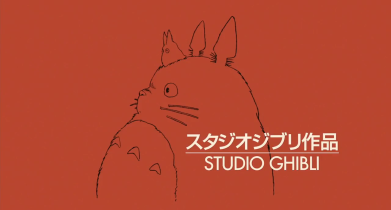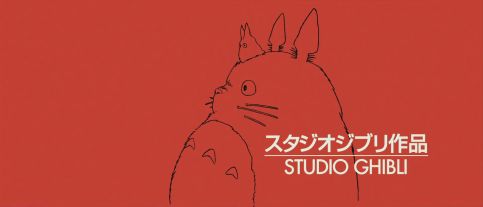Studio Ghibli (Japan)
Jump to navigation
Jump to search
Logo description by Logoboy95 and TheBigLogoFan2
Nicknames: "Totoro the Forest Spirit", "The My Neighbor Totoro Logo"
Logo: On a blue background, we see a drawing of the character Totoro from the film My Neighbor Totoro. Another creature is also seen on his head. The Japanese characters "スタジオジブリ作品" are seen on the bottom right, and underneath that is "STUDIO GHIBLI" in Futura, with a line above it.
Logo capture by Logoboy95
Video captures courtesy of movierelatedlogos and gog129
Background: Studio Ghibli, Inc. (株式会社スタジオジブリ, Kabushiki-gaisha Sutajio Jiburi) is a Japanese animation film studio founded in 1985 (even though they technically produced their first film in 1984), and previously was a subsidiary of Tokuma Shoten. The company's logo features the character Totoro from the film My Neighbor Totoro. Several anime features created by Studio Ghibli have won the Animage Anime Grand Prix award including Laputa: Castle in the Sky in 1986, My Neighbor Totoro in 1988, and Kiki's Delivery Service in 1989. In 2002, Spirited Away won an Oscar for Best Animated Feature, the first anime film to win an Academy Award. However, Studio Ghibli never used this logo until 1991, instead they used "TOKUMA RELEASING PRESENTS" in their films. On August 3, 2014, Hayao Miyazaki (the director) retired, temporarily halting production. However, Miyazaki came out of retirement in February 13, 2017 and announced a new movie, which is currently in production.
(July 20, 1991- )
Video captures courtesy of movierelatedlogos and gog129
Background: Studio Ghibli, Inc. (株式会社スタジオジブリ, Kabushiki-gaisha Sutajio Jiburi) is a Japanese animation film studio founded in 1985 (even though they technically produced their first film in 1984), and previously was a subsidiary of Tokuma Shoten. The company's logo features the character Totoro from the film My Neighbor Totoro. Several anime features created by Studio Ghibli have won the Animage Anime Grand Prix award including Laputa: Castle in the Sky in 1986, My Neighbor Totoro in 1988, and Kiki's Delivery Service in 1989. In 2002, Spirited Away won an Oscar for Best Animated Feature, the first anime film to win an Academy Award. However, Studio Ghibli never used this logo until 1991, instead they used "TOKUMA RELEASING PRESENTS" in their films. On August 3, 2014, Hayao Miyazaki (the director) retired, temporarily halting production. However, Miyazaki came out of retirement in February 13, 2017 and announced a new movie, which is currently in production.
(July 20, 1991- )
<iframe frameborder="0" height="211" src="http://wikifoundrytools.com/wiki/closinglogos/widget/unknown/3f8e348e6379a0271396a99de75d7f39408ff769" width="368"></iframe><iframe frameborder="0" height="213" src="http://wikifoundrytools.com/wiki/closinglogos/widget/unknown/7168c4b48b8f67af21572705b21d9721e26b511b" width="286"></iframe>
Note: The Ghiblies: Episode 2 trailer variant starts at 0:26 in the second video.
Logo: On a blue background, we see a drawing of the character Totoro from the film My Neighbor Totoro. Another creature is also seen on his head. The Japanese characters "スタジオジブリ作品" are seen on the bottom right, and underneath that is "STUDIO GHIBLI" in Futura, with a line above it.
Variants:
FX/SFX: None, except for the fade in and fade out.
Music/Sounds: None, or the opening theme of the movie.
- After the logo, a Presents screen appears crediting various companies who assisted the production of whatever movie is shown in ether Japanese or English (depending on the print that is used).
- Starting with Howl's Moving Castle in 2005, this logo was updated to a light blue background, from the previous dark blue. The text appears to be more bolder. HD masters of Ghibli movies use this version instead of the previous one.
- On the HD master of Pom Poko (on at least the British Blu-Ray), the image of Totoro is white and looks glitchy. This is very likely an error with the print used.
- A special variant was seen on the Ghiblies: Episode 2 trailer. The image of Totoro is slightly off-center, then it rotates to reveal a character from the show using a laptop. He removes "ジブリ作品" using his laptop, then reenters it as "ギブリ作品", making it "スタジオギブリ作品" (Sutajio Giburi, an alternate spelling of the Japanese name).
- On the short Giant God Warrior Appears in Tokyo, the logo has a red background, is in scope, and has a film effect. Its also positioned to the right.
- OnThe Red Turtle, the logo's background is also red, which is to honor the film's titular character itself. The logo is centered compared to the previous one.
- On the 1994 Fox Video release of My Neighbor Totoro, the logo fades out and goes straight to the "this film has been modified" screen.
FX/SFX: None, except for the fade in and fade out.
Music/Sounds: None, or the opening theme of the movie.
Music/Sounds Variants: On the German dubbings of Howl's Moving Castle and Nausicaä of the Valley of the Wind, it uses the last half of the VIP Media Group fanfare (likely due to a reverse plaster). This oddity can be seen on the Region 2 DVDs of the aforementioned titles.
Availability: Common. Can be seen on Studio Ghibli movies since 1991 starting with Isao Takahata's Only Yesterday, but also put at the beginning of the re-releases of older Ghibli films such as Castle in the Sky, My Neighbor Totoro and Kiki's Delivery Service among others. It is also used as a de-facto home video logo on releases of their material since around 2009 (it was also used on the 1994 Fox Video release of My Neighbor Totoro) following the logo for whatever distributor distributes their material (the North American Disney releases however only have their logo).
Availability: Common. Can be seen on Studio Ghibli movies since 1991 starting with Isao Takahata's Only Yesterday, but also put at the beginning of the re-releases of older Ghibli films such as Castle in the Sky, My Neighbor Totoro and Kiki's Delivery Service among others. It is also used as a de-facto home video logo on releases of their material since around 2009 (it was also used on the 1994 Fox Video release of My Neighbor Totoro) following the logo for whatever distributor distributes their material (the North American Disney releases however only have their logo).
Editor's Note: Not the best logo in the world, but their movies more than make up for it.



